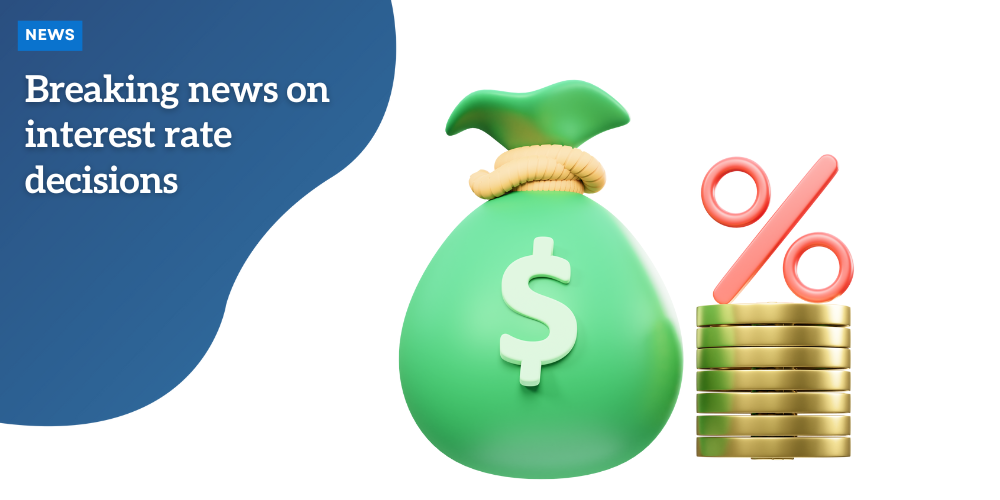Breaking news on interest rate decisions

Anúncios
Interest rate decisions fundamentally impact consumer loans, savings, and spending, with changes influenced by economic indicators like inflation, employment, and global events.
Breaking news on interest rate decisions can significantly influence our financial lives. Have you ever wondered how these decisions affect your savings and loans? Let’s dive into the latest updates and explore what they mean for you.

Understanding interest rate decisions
Understanding interest rate decisions is essential for anyone navigating the financial landscape. These decisions can impact everything from mortgages to savings accounts.
Anúncios
The central bank plays a crucial role in setting these rates, influencing the economy as a whole. When they raise rates, borrowing becomes more expensive, which can slow down spending. Conversely, lowering rates generally stimulates spending and investment.
Factors Influencing Interest Rate Decisions
Several factors contribute to how interest rates are determined. Economic conditions, inflation rates, and even geopolitical events can influence these decisions. Here are key factors to consider:
- Inflation: Higher inflation often leads to increased interest rates to control spending.
- Economic Growth: A growing economy can prompt the central bank to raise rates to prevent overheating.
- Employment Rates: Low unemployment may push rates higher due to increasing consumer spending.
- Global Events: Political instability or financial crises abroad can impact domestic interest rates.
As you can see, the relationship between these factors and interest rate decisions is complex. Keeping an eye on economic indicators can provide valuable insight into future rate changes. For instance, if inflation begins to rise, it’s likely that rates will follow suit. Understanding these dynamics can empower you to make more informed financial choices.
The Role of the Central Bank
The central bank’s role in the economy cannot be overstated. It uses interest rates as a tool to promote economic stability. By adjusting rates, the bank aims to control inflation and stabilize the currency. That means they carefully assess various economic data before making a decision. Moreover, their announcements regarding interest rates can lead to immediate market reactions.
The impact of interest rates extends beyond the financial markets. Consumers feel these effects in their daily lives, from higher loan payments to changes in savings interest. Keeping track of what drives these decisions can help you better plan your financial future.
Anúncios
Impact of rates on consumers
The impact of rates on consumers is far-reaching and crucial to understand. Changes in interest rates can significantly affect your everyday financial decisions, from loans to savings. For instance, when interest rates rise, borrowing money typically becomes more expensive.
This can lead to higher monthly payments on mortgages and car loans. If you have a variable-rate loan, you might notice that your payments increase as rates go up. In contrast, when rates drop, it can lead to more affordable loan options for consumers. People are more likely to take out loans when they know they will pay less in interest.
Effects on Saving and Spending
Interest rates also influence consumer behavior regarding saving and spending. Higher rates can encourage saving, as people get more return on their deposits. Conversely, low rates might motivate spending because the return on savings is less appealing.
- Saving Rates: When rates are high, consumers save more due to better returns.
- Loan Repayments: Consumers face larger repayments on existing debts if interest rates rise.
- Twist in Spending: Lower rates generally lead to increased consumer spending.
- Investment Choices: Consumers may seek alternative investments when rates are low to maximize returns.
Understanding how interest rates affect consumer choices can help in making informed financial decisions. Whether you are buying a home or saving for the future, being aware of the current interest rate environment is key.
Influence on Credit Accessibility
The accessibility of credit is heavily influenced by interest rates. When rates are low, lenders are often more willing to extend credit to consumers. This can lead to more loans being approved for homes, cars, and even personal loans. High-interest rates, on the other hand, often mean tighter lending standards, as banks aim to minimize risks. This could result in fewer approvals for loans and credit cards, making it harder for consumers to access the funds they need.
As such, the direct effects of interest rate changes on borrowing capabilities can shape the overall economic landscape as well, affecting not only individual finance but also broader economic growth.
Economic trends influencing rates
Economic trends play a significant role in shaping interest rate decisions. These trends reflect the overall health of the economy and can influence how central banks adjust rates.
For example, when the economy is growing, demand for goods and services increases. This heightened demand can lead to inflation, prompting central banks to raise interest rates to keep inflation in check. On the other hand, during an economic downturn, rates may be lowered to encourage spending and investment.
Key Economic Indicators
Several key economic indicators help to guide interest rate decisions. These include:
- GDP Growth: A rising Gross Domestic Product (GDP) suggests economic strength, often leading to higher interest rates.
- Unemployment Rates: Low unemployment generally correlates with increased consumer spending, which can spur inflation.
- Consumer Confidence: A more confident consumer base tends to spend more, influencing borrowing and interest rates.
- Inflation Metrics: Central banks closely monitor inflation data to decide on rate adjustments.
Understanding these indicators aids consumers in predicting potential rate changes and making informed financial decisions. For instance, if GDP is growing robustly, you might anticipate rising interest rates in the near future.
Global Economic Influences
The global economic landscape also affects interest rate decisions. Events such as trade agreements, political stability, and international market trends can drive changes in domestic rates. If a major economy faces challenges, it can ripple through global markets, influencing local interest rates.
The interconnectedness of global markets means that central banks consider international conditions when setting rates. Additionally, the actions of other central banks around the world can lead to competitive adjustments in interest rates, impacting consumer and business borrowing.
By staying informed about global economic trends and understanding their impact on interest rates, consumers can better navigate their financial futures.
Future outlook for interest rates
The future outlook for interest rates is a topic of great interest for consumers and investors alike. Understanding potential trends can help you make sound financial decisions.
Analysts look at various factors to predict interest rate movements. This includes reviewing current economic data, inflation expectations, and central bank guidance. Predictions can change based on new economic data or unforeseen circumstances.
Current Economic Conditions
Many believe that as the economy continues to recover, the central bank may consider increasing rates. A growing economy often leads to higher demand, which can result in inflation. If inflation rises above target levels, it could prompt the central bank to raise interest rates to stabilize prices.
- Inflation Trends: Rising inflation rates may lead to increased interest rates.
- Employment Levels: A decrease in unemployment often indicates a robust economy, influencing rate changes.
- Consumer Spending: Higher spending may contribute to inflation, impacting rates.
- Central Bank Policies: Future decisions from the central bank can directly affect interest rate expectations.
As the economy evolves, consumers should stay informed about these factors. Rate changes can affect loans, mortgages, and savings rates, impacting personal finances directly.
Global Influences on Rates
The global economic environment also plays a crucial role in shaping future interest rates. Events such as international trade agreements and economic policies from other nations can lead to shifts in domestic rates. If other countries raise rates, domestic central banks may follow suit to remain competitive.
Moreover, geopolitical events can all impact financial markets and investor confidence, further influencing interest rates. Monitoring these global developments is essential for anticipating changes in the domestic interest rate landscape.
Understanding these intricate connections can provide consumers and investors with a clearer picture of what to expect in the future regarding interest rates.
interest rate decisions is vital for managing your financial future. Changes in rates can significantly affect your loans, savings, and overall spending. As the economy evolves, keeping an eye on trends and central bank actions will help you make informed choices. By staying informed, you can navigate the impacts of interest rates effectively and take advantage of opportunities as they arise.
FAQ – Frequently Asked Questions about Interest Rate Decisions
How do interest rate changes affect my loan payments?
When interest rates rise, your loan payments may increase, especially if you have a variable-rate loan. Lower rates generally mean smaller payments.
What factors influence future interest rate decisions?
Factors such as inflation, economic growth, unemployment rates, and global economic conditions play a significant role in interest rate decisions.
Why does the central bank change interest rates?
The central bank changes rates to manage inflation, stabilize the economy, and promote employment by influencing borrowing and spending.
How can I stay informed about interest rate changes?
You can monitor economic news, follow reports from financial institutions, and keep track of indicators like GDP and inflation rates to anticipate changes.






